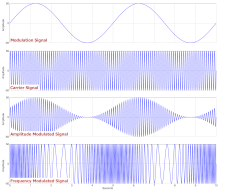Modulation
Modulation is a process that takes a simple signal (like a sine wave) and encodes another signal within it to transmit information. It allows analog and digital data to travel across radio waves, telephone wires, and coaxial cable lines. Devices that modulate and demodulate signals to transmit data over the Internet are called modems.
First, a circuit called a modulator receives an incoming signal, known as a modulation signal, containing some data to transmit. This modulation signal can be analog data, like an audio signal from a microphone, or a digital signal called a bitstream. The modulator merges the modulation signal with a higher-frequency signal, called a carrier signal or carrier wave, by altering its amplitude, frequency, or phase. That carrier wave travels over a transmission medium like radio waves or transmission wire. A demodulator on the other end receives the signal and applies a reverse process to separate the modulation signal from the carrier signal.
Analog Modulation
The most common use for analog modulation is transmitting radio signals over long distances. It used to be the primary method for sending other signals like television and voice communication, but those signals now use digital modulation instead.
There are three primary methods used to modulate analog signals:
- Amplitude Modulation (AM) modulates a signal by making the amplitude of the carrier wave stronger or weaker to carry the modulation signal while the carrier wave's frequency remains constant.
- Frequency Modulation (FM) modulates a signal by keeping the amplitude constant but changing the carrier wave's frequency based on the modulation signal. FM is less susceptible to interference than AM.
- Phase Modulation (PM) modulates a signal by changing the carrier wave's phase based on the amplitude of the modulation signal. Both the amplitude and frequency of the carrier wave remain constant.
Digital Modulation
Digital modulation can transmit digital data bitstream over analog signals, like over phone or cable lines (using modems) or digital radio signals (Wi-Fi, Bluetooth, or cellular).
Instead of modulating a carrier wave to carry another signal, digital modulation modulates the carrier wave to transmit a bitstream. The most basic form of digital modulation sends one bit at a time by switching the signal between two states: on (1) and off (0). The number of times that a modulated signal can change per second is known as the baud rate.
More advanced methods use a modulation alphabet to transmit data more efficiently. A modulation alphabet can encode multiple bits into a single tone. For example, one method may encode groups of 2 bits using four distinct tones — one tone for 00, another for 01, a third for 10, and the fourth for 11. A method that encodes 4 bits at a time would instead use 16 different tones.
There are many types of digital modulation, but the most common types are as follows:
- Phase-Shift Keying (PSK) modulates a signal by changing the phase of the carrier wave between a finite set.
- Frequency-Shift Keying (FSK) modulates a signal by changing the carrier wave's frequency between a finite set of frequencies. Audio Frequency-Shift Keying (AFSK) is a digital modulation method used in early computer modems.
- Amplitude-Shift Keying (ASK) modulates a signal by changing the amplitude of the carrier wave between a finite set of amplitudes. ASK modulation transmits digital data over fiber optic lines by changing the amplitude of the light sent over the cables.
- Quadrature Amplitude Modulation (QAM) modulates a signal by changing the amplitude of two separate carrier waves that are out of phase with each other. QAM is part of the Wi-Fi communications specification.
 Test Your Knowledge
Test Your Knowledge